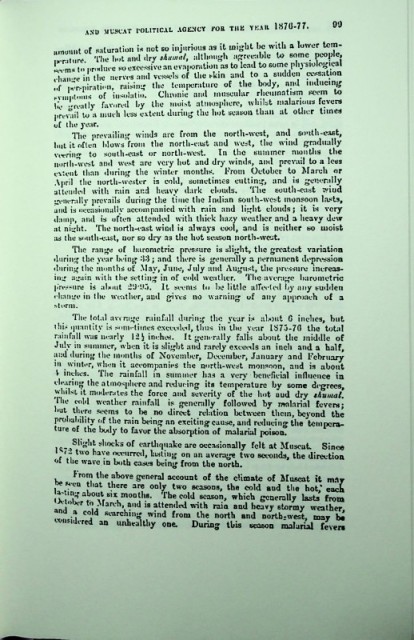Page 347 - PERSIAN GULF ADMINISTRATION REPORTS V1
P. 347
y ear 1870-77. 01)
AND MUSCAT POLITICAL AGENCY FOE T1!K
„t of saturation is not so injurious as it might be with a lower tem-
ainou
nrrature. 'Hie hot and dry shumil, although agreeable to some people,
Lvms to produce so excessive an evaporation as to lead to some physiological
rt. in the nerves and vessels of the skin and to a sudden cessation
«,f i>c inspiration, raising the temperature of the body, and inducing
Miiiptn.ns of insolatio. Chronic and muscular rheumatism seem to
’ really favored by the moiat atmosphere, whilst malarious Fevers
be
prevail to a much less extent during the hot season than at other times
vf the year.
The prevailing winds arc from the north-west, and south-east.
hut it often blows from the north-east and west, the wind gradually
veering to south-east or north-west. In the summer months the
.
north-west and west are very hot and dry winds, and prevail to a less
extent than during the winter months. From October to March or
April the north-wester is cold, sometimes cutting, and is generally
attended with rain and heavy dark clouds. The south-east wiud
generally prevails during the time the Indian south-west monsoon lasts,
and is occasionally accompanied with rain and light clouds; it is very
damp, and is often attended with thick hazy weather and a heavy dew
at night. The north-east wind is always cool, and is neither so moist
as the south-east, nor so dry as the hot season north-west.
The range of barometric pressure is slight, the greatest variation
during the year being 83; and there is generally a permanent depression
during the months of May, June, July and August, the pressure increas
ing again with the setting in of cold weather. The average barometric
pressure is about 21HJ5. It seems to be little affected by any sudden
change in the weather, and gives no warning of any approach of a
storm.
The total average rainfall during the year is alxmt G inches, but
this quantity is sometimes exceeded, thus in the year 1875-70 the total
rainfall was nearly 12 J inches. It generally falls about the middle of
July in summer, when it is slight and rarely exceeds an inch and a half,
and during the months of November, December, January and February
in winter, when it accompanies the north-west monsoon, and is about
V inches. The rainfall in summer has a very beneficial influence in
clearing the atmosphere and reducing its temperature by some degrees,
whilst it moderates the force and severity of the hot- aud dry thumal.
I he cold weather rainfall is generally followed by malarial fevers;
»ut there seems to be no direct relation Ijetween them, beyond the
probability of the rain being an exciting cause, and reducing the tempera
ture of the body to favor the absorption of malarial poison.
. SMit shocks of earthquake are occasionally felt at Muscat. Since
two have occurred, lasting on an average two seconds, the direction
of the wave in both cases being from the north.
From the above general account of the climate of Muscat it may
*cn that there are only two seasons, the cold aud the hot/ each
' ing about s!x months. The cold season, which generally lasts from
_nlox?r March, and is attended with rain and heavy stormy weather
na a cold searching wind from the north and north-west, may hi
-i i red an unhealthy one. During this season malarial fevers

